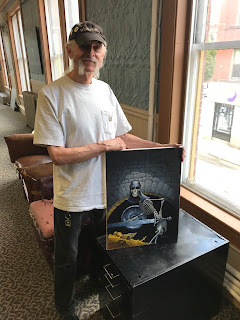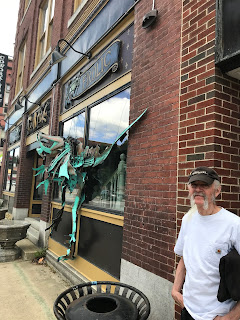 |
| Kane navigating his skeleton crew. |
Sword-and-sorcery and horror are bedfellows. The former is
fantasy infused with the grit of history, but also the chill hand of terrors
terrestrial and otherworldly. Few writers bridged this gap so skillfully as
Karl Edward Wagner (1945-1994).
Today marks the 25th anniversary of Wagner’s
death. His untimely passing at 49 was a massive blow to my favorite subgenre. Wagner
was one of sword-and-sorcery’s fiercest and most articulate champions, even if
he didn’t like the term (1). Wagner championed Howard at a time when the massively
popular Lancer/Ace Conan Saga was still at its zenith, and its heavy-handed
editing and Conan pastiche was largely getting a pass. Wagner cut against the
grain, arguing that Howard was a writer of literary merit whose works were worth
preserving, not a property to exploit. That didn’t sit well with Conan Saga
editor L. Sprague de Camp.
Wagner oversaw the publication of pure Howard in a three
volume set published in 1977 by Berkley Medallion—The Hour of the Dragon, The People of the Black Circle, and Red Nails. The Berkley Conans restored
Howard’s texts using the Weird Tales
originals. Wagner had intended to publish all 21 Conan stories, but “contractual
difficulties” ended the Berkleys after just three volumes. So we got just eight
tales, plus Howard’s “The Hyborian Age” essay.
Wagner’s introductions and afterwords alone make tracking
down the Berkleys worth the effort. Their presentation of the Conan stories—art,
design, and of course, Wagner’s essays—remains a personal favorite of mine,
even though I admit they have been supplanted by the Del Reys. I’m hoping one
day to score copies with the Ken Kelly foldout posters intact. Mine were bought
used and the posters were gone, probably adorning some young fan’s fake
wood-paneled bedroom wall in the late 70s.
As the sun was setting on sword-and-sorcery (and his own
life) Wagner edited Echoes of Valor,
a three-volume series published by Tor with volumes appearing in 1987, 1989,
and 1991. As its name implies Echoes of
Valor served up classic pulp era sword-and-sorcery, some of it for the first
time. Vol. 1 featured Robert E. Howard’s “The Black Stranger,” original
appearance in the March 1953 Fantasy
Magazine; Fritz Leiber’s “Adept’s Gambit,” which made its original
appearance in the 1947 Arkham House collection Night’s Black Agents; and Henry Kuttner’s “Wet Magic,” first
appearance in the February 1943 Unknown
Worlds. Vol. 2 contained two versions of Howard’s “The Frost Giant’s
Daughter,” as well as stories by C.L. Moore and Manly Wade Wellman, and a
collaboration by Leigh Brackett and Ray Bradbury, “Lorelei of the Red Mist.”
Vol. 3 included Howard’s “The Shadow of the Vulture” featuring Red Sonya, more
stories by Kuttner and Wellman, and tales by Jack Williamson and the enigmatic
Nictzin Dyalhis.
The Echoes of Valor
versions of “The Black Stranger and “The Frost-Giant’s Daughter” are noteworthy.
The latter marked the first mass-market appearance of the story as Howard
himself wrote it, unlike the heavy-handed de Camp edited version in the Lancer
Conan Saga, while “The Black Stranger” was reproduced from a photocopy of the original
manuscript, prior to Howard’s attempt to rewrite the rejected story as “Swords
of the Red Brotherhood.” As with the Berkley Conans, Wagner’s introductions in Echoes of Valor are well-worth reading,
and his enthusiasm and erudition for pulp fantasy shines through.
Wagner not only championed sword-and-sorcery but added a
powerful verse with his stories of Kane. I consider Bloodstone (1975) a Rosetta Stone (no pun intended) for the
sword-and-sorcery genre. If you want to understand what sword-and-sorcery is
all about you could certainly start with “Ill Met in Lankhmar” or “Beyond the
Black River” (both great options), or you could find a second-hand copy of this
gonzo story of a lost city deep in the swamps, guarded by an army of frog-men,
and the corruptive power of technology wrapped up a green and red stone
possessed of alien intelligence. Sword-and-sorcery introduced the figure of the
Outsider to fantasy, and Kane is very much a self-serving antagonist in Bloodstone, albeit compelling and
relatable. I recommend any of the Kane stories, but in particular “Undertow,” “Lynortis
Reprise,” “Sing a Last Song of Valdese,” “Reflections for the Winter of my
Soul,” and Darkness Weaves.
Aside: It’s borderline
criminal that the Kane stories have fallen out of print. Wagner’s books are
increasingly harder to find and growing more expensive by the day on the
second-hand market. Those sold out Centipede Press
editions? If you can find one used, which is rare, the complete set
will run you upwards of a thousand bucks. Midnight Sun alone (Nightshade Books)
is fetching $135 and up, used, on Amazon. The Donald M. Grant Book of Kane will
run you from $100 up to $300 on Abe Books. Apparently the Kane books are now
available on Kindle, but since I have no interest in e-readers I don’t consider
that a viable option. Fortunately I have my complete line of battered Warners.
But this scarcity situation needs to be rectified by Wagner’s estate, pronto.
I wish I had the opportunity to meet Wagner at a bar at a
convention, knock back a whiskey or five, and talk horror and dark fantasy long
into the night. He knew these fields and he wasn’t afraid to express his
opinion, articulately. He was a titan of horror, serving as editor of the
yellow-spined DAW Year’s Best Horror anthology from 1979 until his death in
1994. For 15 years he was one of its most recognized and respected critics, and
his work as an anthologizer ranks in my opinion right alongside the likes of
Charles L. Grant and Stephen Jones. Wagner also wrote some incredible, enduring
works of horror fiction, including “Sticks,” which won an August Derleth Award
from The British Fantasy Society as the best short fiction of 1974. I think it’s
top to bottom his most effective piece of fiction. I also highly recommend his
incredibly atmospheric and creepy “Where The Summer Ends” from the Kirby
McCauley edited Dark Forces.
With his pedigree in and deep passion for horror it’s no
wonder that the Kane stories are eerily fantastic, infused with a Gothic
sensibility, and at times skin crawling. For example, this passage from “Cold
Light”:
An
ingenious trap had cut down most of Kane’s forces, and he had fled westward
into the ghost land of Demornte. Here his enemies would not follow, for the
plague which had annihilated this nation was still held in utmost dread, and
although it had struck this desert locked land nearly two decades before, still
no one entered and no one left silent Demornte.
Dead
Demornte. Demornte whose towns lie empty, whose farms are slowly returning to
forest. Demornte where death has lain and life will no more linger. Land of
death where only shadows move in empty cities, where the living are but a
handful to the countless dead. Demornte where ghosts stalk silent streets in
step with the living, where the living walk side by side with their ghosts. And
a man must look closely to tell one from the other.
With a full three score years and ten I believe Wagner would
have written more Kane stories. I believe he would have given us another
S&S anthology, even though Echoes of
Valor petered out and the appetite for such fiction was at its lowest ebb
in the early 90s. He might have been involved with the Del Reys, penning some
of the intros or afterwards for the series which has finally given us the full
unadulterated measure of the likes of Kull, Conan, Solomon Kane, and Bran Mak
Morn.
But it was not to be.
So, 25 years gone, and the world is poorer for his death.
But those who know and love horror and sword-and-sorcery remember Karl Edward
Wagner.
Notes
1. Wagner much preferred “epic fantasy” or “dark
fantasy” to “sword-and-sorcery,” which he despised. He loved Howard, but hated
his imitators. Here is Wagner from an interview appearing on East of Eden: “’Sword and sorcery’ conjures
an image of yarns about girls in brass bras who are in constant danger of
losing them, and mighty warriors with eighteen-foot-long swords killing wizards
and monsters faster than thought. A sword fight every other page, kill a
monster every other chapter, and rescue a girl at the end—there’s your sword
and sorcery yarn.”























